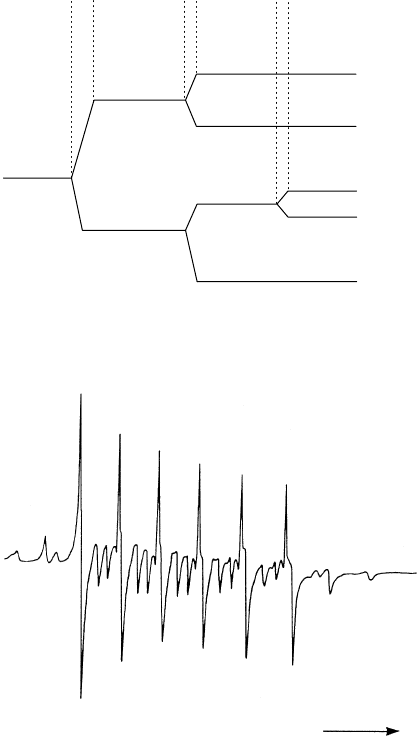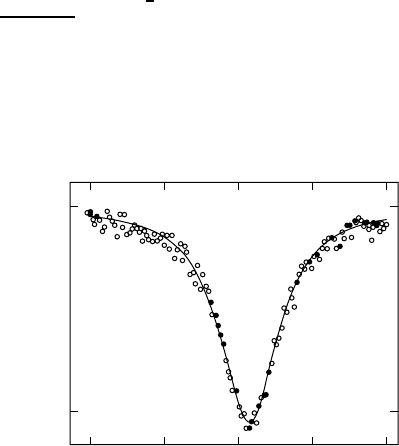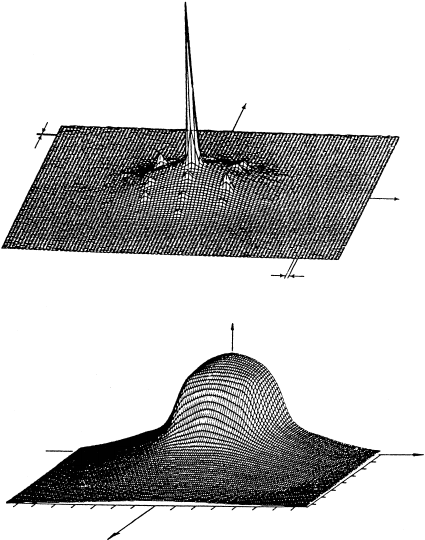Gersten J.I., Smith F.W. The Physics and Chemistry of Materials
Подождите немного. Документ загружается.


494 CHARACTERIZATION OF MATERIALS
The first-order splitting caused by such an interaction may be obtained for the eigen-
states jI, mi as
hI, mjHjI, miD¯h8B
0
m C
e
2
Qq
4I2I 1
[3m
2
II C 1].W22.205
The effect of the Zeeman term is to lift the degeneracy by spreading out the sublevels
uniformly. The effect of the quadrupole coupling is to raise (or lower) states with šm
by the same amount. The combined effect is to produce a nonuniform spreading of
the sublevels. The magnetic-dipole selection rule is m Dš1. The transitions may
be tracked in a resonance experiment, and the value of eqQ maybeobtainedtohigh
precision.
For the case where there is no axial symmetry the formulas are more complicated.
For I D 1 one finds that
h1,mjHj1,miD
e
2
2
qQ if m D 0,
Ý8B
0
C
e
2
qQ
4
1 š?, if m Dš1,
W22.206
and for I D
3
2
one finds that
3
2
,mjHj
3
2
,m
D
Ý
8B
0
2
C
e
2
4
qQ
1 C ?
2
/3, if m Dš
1
2
,
Ý
38B
0
2
e
2
qQ
4
1 C ?
2
/3, if m Dš
3
2
.
W22.207
Typical values of Q are presented in Table W22.4, along with nuclear spins, abun-
dances, and Zeeman (precession) frequencies for magnetic-dipole transitions. Nuclear
quadrupole resonance provides information about bond hybridization and the cova-
lent nature of the chemical bond. For example, if there is sp-hybridization, only the
p-orbital contributes to the quadrupole moment. Similarly, in ionic bonding, the closed-
shell ions do not possess quadrupole moments.
TABLE W22.4 Spins, Abundances, Precession Frequencies, and Quadrupole Moments
for Some Nuclei
Isotopic
Spin Abundance fB D 1TQ
Nucleus I (%) (MHz) (10
30
m
2
)
2
H 1 0.015 42.5764 0.2860
11
B
3
2
80.1 13.6626 4.059
17
O
5
2
0.038 5.7741 2.558
25
Mg
5
2
10.00 2.6082 19.94
27
Al
5
2
100 11.1028 14.03
Source: DatafromD.R.Lide,ed.,CRC Handbook of Chemistry and Physics, 75th ed., CRC Press, Boca
Raton, Fla., 1997.
CHARACTERIZATION OF MATERIALS 495
W22.32 Electron-Spin Resonance
Much of the inner workings of atoms has been elucidated by employing resonance
techniques in conjunction with the use of external magnetic fields. The physics of the
atom is described in terms of a succession of contributions to the Hamiltonian. These
describe the kinetic energy, the electrostatic interaction between the electrons and the
nucleus, the electron–electron electrostatic interactions, the spin–orbit coupling, the
spin–spin interaction, the interaction of the electron orbital angular momentum L and
spin S with external magnetic fields, the hyperfine interaction, the nuclear Zeeman and
quadrupole couplings, and various relativistic and quantum-electrodynamic corrections.
If the atom is not free but is embedded in a crystal, one must, in addition, consider the
effect of the crystal electric field imposed by the neighboring ions and electrons, the
interaction of the atomic spin with the spins on nearby atoms, and the possibility of
losing electrons to or gaining electrons from other atoms of the solid. These effects are
often by no means small and lead to major perturbations of the energy levels and the
corresponding spectroscopy. To the extent that they can be understood, however, they
provide a powerful analytical tool for probing the solid. The field is called electron-spin
resonance (ESR) or sometimes electron paramagnetic resonance (EPR). For simple
electron-spin systems, ESR may be described in terms of the Bloch equations, although
the quantum-mechanical approach is used in this section.
ESR is a very rich field and cannot be summarized adequately in a short amount of
space. It can provide information concerning donor or acceptor impurities in semicon-
ductors. It can be used to study transition metal ions. It is useful for analyzing color
centers in insulators. It is sensitive to electron and hole traps. There are two simple
uses for it: determining the symmetry of the site where the spin sits and determining
the valence of the magnetic ion.
In atomic physics one is concerned with the coupling of the nuclear spin, I,to
the electronic spin, J D L C S, to form a total angular momentum F D I C J.Inthe
presence of a magnetic induction B D
O
kB
0
, the Hamiltonian for a given electronic term
is written as
H D (L
· S C
B
B · L CgS C AS · I C
N
B · I,W22.208
where the first term is the spin–orbit coupling, the second term is the electronic Zeeman
effect, the third term represents the hyperfine coupling, and the last term is the nuclear
Zeeman effect (which is three orders of magnitude weaker). The parameter g is the
g factor of the electron and is approximately 2. One usually forms matrix elements
of this Hamiltonian in an appropriate basis, diagonalizes the matrix, and interprets the
eigenvalues as the energy levels. Resonance spectroscopy may then be used to drive
transitions between the energy levels and therefore to deduce the coupling constants,
( and A, as well as to determine L, S,andI.
The same basic idea is used in the solid, but the Hamiltonian becomes more compli-
cated. First, quenching of the orbital angular momentum may occur. This occurs in
the sp-bonded materials and transition metal ions (but not in the rare earths with f
electrons, which need to be considered separately). Since the crystal is not an isotropic
medium, the mean orbital angular momentum operator does not commute with the
potential energy function. On the other hand, to a first approximation, the electron and
nuclear spins are impervious to the presence of this anisotropy. In place of the full
rotational symmetry of the free atom, there is the point-group symmetry of the crystal.

496 CHARACTERIZATION OF MATERIALS
A fruitful approach is to try to write a Hamiltonian operator involving S, I,andB in
a form that will respect the symmetry operations of the crystal. This will often require
introducing more than two arbitrary constants. Resonance techniques are able to deter-
mine these parameters in the same way as they are determined for a free atom. The
size of the parameters often offers important clues to the nature of the chemical bonds
formed. Moreover, a study of the degeneracies and their lifting under the application
of a magnetic field allows valuable information concerning the valency and symmetry
of the paramagnetic ions to be obtained.
As an example, consider the case of a magnetic ion sitting on a site with octahedral
symmetry inside a cubic host crystal. The Hamiltonian may be written as
H D g
B
B · S CAS · I C CS
4
x
C S
4
y
C S
4
z
C DS
6
x
C S
6
y
C S
6
z
CÐÐÐ,W22.209
where the higher-order terms are usually smaller than the lower-order terms and are
often neglected. This Hamiltonian respects the cubic symmetry of the crystal in that
the permutation x ! y ! z ! x is a symmetry operation (rotations of 120
°
around
the main diagonal), as is x !x (reflections in bisecting planes), x, y ! y, x
(90
°
rotations), and so on.
Now suppose that a tetragonal distortion is introduced in the crystal. The x and y
lattice constants are assumed to remain the same, but the z lattice constant is made
different. This introduces new parameters into the Hamiltonian:
H D g
z
B
S
z
B
z
C g
xy
B
[S
x
B
x
C S
y
B
y
] C A
z
S
z
I
z
C C
0
S
2
z
C A
xy
[S
x
I
x
C S
y
I
y
] C P
$
I
2
z
1
3
II C 1
%
,W22.210
where higher-order terms have been dropped.
If the symmetry is lifted further, by creating an orthorhombic distortion, the Hamil-
tonian is expanded even further:
H D g
z
B
S
z
B
z
C g
x
B
S
x
B
x
C g
y
B
S
y
B
y
C A
z
S
z
I
z
C A
x
S
x
I
x
C A
y
S
y
I
y
C P[I
2
z
1
3
II C 1] C C
0
S
2
z
C C
00
S
2
x
S
2
y
. W22.211
A typical lifting of the degeneracy is represented in Fig. W22.54 for the case of a
d-shell electron. The ten-fold degenerate level for the free ion is split in stages and
ultimately consists of five doubly degenerate levels.
In Fig. W22.55 results are presented for a Mn
2C
ion in a calcite host crystal, CaCO
3
.
In the presence of the magnetic field the S D 5/2 level is Zeeman-split into 2I C 1 D 6
lines. The widths of the lines are attributed mainly to random strains in the crystal.
W22.33 M
¨
ossbauer Spectroscopy
Consider the gamma decay of an isolated radioactive nucleus in an excited state I
resulting in a ground-state nucleus F. A gamma ray of energy ¯hω is emitted in one
direction and nucleus F recoils with momentum ¯hω/c in the opposite direction. The total
energy available in the transition is the sum of the photon energy and the recoil energy:
E D ¯hω C ¯hω
2
/2Mc
2
,whereM is the nuclear mass. The photon that is emitted cannot
be absorbed by another F nucleus, because it is shifted out of resonance (i.e., ¯hω < E.

CHARACTERIZATION OF MATERIALS 497
Isotropic Octahedral Tetragonal Orthorhombic
2
3
2
1
1
1
1
1
z
2
yz
xz
xy
x
2
− y
2
Figure W22.54. Lifting of the degeneracy of the d-electron energy levels as the symmetry of
the crystal is lowered.
B
Figure W22.55. ESR spectrum of a Mn
2C
ion in a calcite host. [Reprinted from J. G. Angus
et al, Chem. Geol., 27, 181 (1979). Copyright 1979, with permission from Elsevier Science.]
The natural width of the emission line, determined by its radiative lifetime, is typically
on the order of several 10
9
eV, much smaller than the recoil energy. There are only
several nuclei that may be used in M
¨
ossbauer spectroscopy. Chief among them is
57
Fe.
The parent nucleus is
57
Co. The sequence of decays is
57
Co !
57
Fe
Ł
C e
, with a half-
life of 271 days, followed by
57
Fe
Ł
!
57
Fe C 8, with a half-life of 99.3 ns. The energy
ofthegammarayusedinM
¨
ossbauer spectroscopy is 14.41 keV, although there are
two others emitted at 123 and 137 keV. Other useful emitters are
119
Sn,
121
Sb,
125
Te,
129
I,
151
Eu,
190
Os, and
197
Au.
Gamma decay often involves a change in the nuclear spin. Due to the hyperfine
interaction there may be several possible values for ¯hω.
Next consider the nucleus embedded in a crystal, which will be called the source
crystal. In the discussion of the Debye–Waller factor, exp2W, the factor was inter-
preted as the probability for the crystal to be found in a periodic arrangement. If the

498 CHARACTERIZATION OF MATERIALS
crystal is periodic, when one atom moves, all atoms must move. Energy conservation
requires E D ¯hω C ¯hω
2
/2NMc
2
,whereN is the number of atoms in the crystal. For
a macroscopic sample the second term is negligible and so it is safe to write E D ¯hω.
Suppose that an attempt is made to absorb the gamma ray using a second crystal. The
absorption process is one in which the inverse process takes place (i.e., F C ¯hω ! I).
In general, this too will involve nucleus I recoiling upon absorption, and even if
E D ¯hω, it would not have sufficient energy to cause the transition. However, recoil-
less absorption is also possible. The probability for this is given by a Debye–Waller
factor for the absorbing crystal. The conclusion is that it is possible to have resonant
energy transfer from one crystal to the other. This is the M
¨
ossbauer effect.
By moving one crystal relative to the other, the gamma rays are Doppler
shifted. This may drive the crystals out of resonance again. Thus, if the
absorber is moved toward the source at velocity
v, it sees a gamma ray at
frequency ω
0
D ω[1 Cv/c/1 v/c]
1/2
³ ω1 Cv/c. By gradually increasing v
and monitoring the transmitted gamma rays through the absorbing crystal, it is possible
to carefully map out the line shape of the gamma ray and hyperfine structure of the
nucleus.
The utility of the M
¨
ossbauer effect is that the line shape and hyperfine splittings
provide information concerning the local electronic environment of the nucleus. One
compares the energy levels in the source with those of the absorber. Each is subject to
a chemical shift (also called an isomer shift ) determined, for example, by its oxidation
state. The M
¨
ossbauer spectrum also provides information about the magnetic fields and
spins in the solid. Thus information is provided in a similar fashion to that obtained
from NMR or NQR studies. For example, one may obtain the quadrupole splitting, as in
NQR. In the case of
57
Fe, with I D
3
2
, the quadrupole splitting is given by the formula
E D e
2
qQ/2
1 C ?
2
/3 [see Eq. (W22.207)]. From a measurement of the Zeeman
splitting, one may determine the strength of the magnetic induction, B, at the nucleus.
An example of a M
¨
ossbauer spectrum is presented in Fig. W22.56. The gamma-ray
source is Mg
125
3
Te
m
O
6
(with a 58-day half-life) and the absorber is ZnTe. The recoil-
less fraction depends on the Debye–Waller factor, exp[2WT]. Equation (W5.13)
100
98
96
−14 −70 714
Velocity (mm/s)
Transmission (%)
ZnTe
(78K)
Figure W22.56. M
¨
ossbauer spectrum produced with the metastable source Mg
125
3
Te
m
-O
6
and the
absorber ZnTe at T D 78 K. [From W. Bresser et al, Phys. Rev. B, 47, 11663 (1993). Copyright
1993 by the American Physical Society.]
CHARACTERIZATION OF MATERIALS 499
gives an expression for WT which may be evaluated using the Debye theory used
to calculate the specific heat of solids. Thus W will also depend parametrically on the
Debye temperature
D
. By studying the M
¨
ossbauer signal as a function of temperature,
it is possible to determine
D
.Avalue
D
D 188 K is found for the absorber.
ELEMENTARY PARTICLES
The final sections of the characterization chapter are concerned with two techniques
that rely on elementary particles other than the familiar ones of ordinary matter. They
are positron-annihilation spectroscopy and muon-precession spectroscopy.
W22.34 Positron-Annihilation Spectroscopy
The positron is the antiparticle of the electron, with the same mass and spin but opposite
charge and magnetic moment (relative to the spin). When positrons come together with
electrons, pair annihilation occurs. If the pair is in a spin-singlet state and is at rest,
two 0.511-MeV gamma rays are emitted in opposite directions. If the pair is in a triplet
state, three gamma rays are emitted, the sum of the energies adding up to the total rest
energy of 1.022 MeV. The rate for singlet decay is much faster than for triplet decay.
In positron-annihilation spectroscopy (PAS) a beam of positrons is directed at a solid
and the resulting gamma-ray distribution is analyzed. Three popular ways of analyzing
the data are to:
1. Measure the time decay of the gamma-ray signal
2. Measure the angular correlation of the gamma rays
3. Measure the energy distribution of the gamma rays
Typical positron sources include
22
Na (:
1/2
D 2.6years, E D 0.54 MeV) and
68
Ge
(:
1/2
D 280 days, E D 1.89 MeV), where E is the energy of the positron. Accelerators
are also often used. The positrons are rapidly thermalized after entering the solid by
making frequent collisions with the electrons and sharing their energy and momentum
with them. The thermalization time is typically 25 ps. The penetration “depth” with 1%
survival against annihilation is ;d D 10 kg/m
2
for a 2-MeV positron, which translates
into approximately 0.003 m for Al, where ; D 2700 kg/m
3
. A typical positron lifetime
in a metal (Mg) is 232 ps.
Positrons, being positively charged, avoid the regions of high positive potential
inside an atom and thus tend to settle as far from the nuclei as possible. If open-volume
defects such as voids or vacancies are present, the emitted positrons are likely to settle
there. Trapping can also occur in dislocations. PAS therefore provides a powerful
method for studying these defects in a crystal. The decay rate per unit volume is
proportional to the probability that both the electron and positron are to be found in
that volume. If the positron is in a vacancy instead of being inside a normal region
of the crystal, this joint probability can be expected to be lower than its normal value
and hence the decay rate will also be different. The decay of the gamma-ray signal in
time will also be modified. This effect may be modeled by simple kinetic equations,
as follows.

500 CHARACTERIZATION OF MATERIALS
Let n
f
be the number of free positrons per unit volume and n
t
be the corresponding
number of trapped positrons per unit volume. Let the decay rate for a free positron
be
f
and for a trapped positron be
t
.LetC be the concentration of traps,
t
the
trapping cross section, and
v the positron speed. The rate of change of the free-positron
density is given by
dn
f
dt
D
f
n
f
C
t
vn
f
.W22.212
The rate of change of the trapped-positron density is
dn
t
dt
D C
t
vn
f
t
n
t
.W22.213
Begin by injecting a pulse of free positrons at time t D 0, so
n
f
0 D n
0
,n
t
0 D 0.W22.214
The kinetic equations are readily integrated to give
n
f
t D n
0
exp[
f
C C
t
vt],W22.215
n
t
t D
c
t
vn
0
f
t
C c
t
v
fexp
t
t exp[
f
C c
t
vt]g.W22.216
The rate of gamma-ray production per unit volume is
dn
8
dt
D n
t
t
C n
f
f
D n
0
f
t
f
C C
t
v
f
t
C C
t
v
exp[
f
C Cv
t
t]
C n
0
C
t
v
t
f
t
C C
t
v
exp
t
t. W22.217
The exponents and amplitudes multiplying the exponentials may be extracted by fitting
the time-resolved gamma-ray decay rate to a two-exponential fit.
PAS may be used to obtain information about the distribution of electrons in
momentum space. In a metal the electrons fill the Fermi sea and therefore have a
momentum distribution whose maximum value is determined by the Fermi energy and
the band structure. The wavefunction of the electron at the location of the positron
may be expanded in momentum eigenstates. The square of the expansion coefficient
gives the probability of finding the electron with that momentum at the positron. The
physics follows from elementary conservation laws.
Let the momentum of the electron be p, the wave vectors of the gamma rays be
k
1
and k
2
, and the momentum of the thermalized positron be approximated by 0.
Momentum conservation gives
¯h[k
1
C k
2
] D p.W22.218
Energy conservation gives
mc
2
C E D mc
2
C
m
2
c
4
C c
2
p
2
D ¯hω
1
C ω
2
, W22.219

CHARACTERIZATION OF MATERIALS 501
where E is the energy of the electron. The gamma-ray dispersion formulas are essen-
tially those in vacuum,
ω
1
D k
1
c, ω
2
D k
2
c. W22.220
Eliminating ω
1
and ω
2
leads to
¯hk
1
C k
2
D mc C
p
2
C mc
2
,W22.221
¯h
2
k
2
1
C k
2
2
C 2k
1
k
2
cos D p
2
.W22.222
where is the angle between k
1
and k
2
. Solving for k
1
yields
¯hk
1
D
1
2c
mc
2
C E š
mc
2
C E
E C mc
2
4mc
2
1 cos
.W22.223
For the solution to be real, this formula must have a nonnegative argument for the
square root. This implies that
1 cos ½
4
1 C
1 C p/mc
2
.W22.224
Let D υ and assume that υ is small. Then this becomes
p
mc
υ
p
mc
.W22.225
If there is a distribution in p values this equation implies that there will be a distribution
in values of υ or, equivalently, of . The momentum distribution of the electrons in
the solid may therefore be probed by measuring the angular-correlation function of the
gamma rays.
Another way to measure the momentum distribution is to keep fixed at and to
measure the energy distribution of the gamma rays. Thus
¯hk
1
D
1
2
mc C
E
c
š p
.W22.226
Taking the nonrelativistic limit gives
¯hω
1
D mc
2
š
pc
2
,W22.227
which shows that a momentum value determines two values for the energy. The distri-
bution of gamma-ray energies may be mapped into a distribution of electron momenta.
Thermalized positrons are emitted from the surfaces of metals as a result of
the negative work functions presented by these metals to positrons, W
C
.Some
examples are W
C
D0.16 eV for Al(100); W
C
D3.0 eV for W(100) and W(110);
W
C
D0.14 eV for Cu(110); W
C
D0.33 eV for Cu (111); and W
C
D1.3eV
for Ni(100). The origin of these negative work functions is largely due to the surface

502 CHARACTERIZATION OF MATERIALS
dipole layer that exists near the surfaces of metals. The positrons that are able to diffuse
close to the surface are ejected with a distribution of kinetic energies centered around
the negative of the work function. The width of the distribution is determined by the
temperature of the solid. The angular distribution of the emitted positrons is sharply
peaked around the surface normal when the surface is atomically flat and clean. For
example, the full width at half maximum for W(100) positrons is ³ 30
°
. Adsorbates
on the surface broaden the emission cone. The emitted positrons may also display
inelastic energy-loss peaks due to the excitation of surface adsorbates, much as is seen
in LEELS experiments involving electrons.
Trapping of positrons by vacancies alters their decay rate, and this can be used to
probe the thermal formation of vacancies in the interior of a solid. Positrons have also
found use in studying multilayer interfaces and in depth profiling.
In addition to positron emission it is also possible for positronium (Ps) to be emitted.
Positronium is a hydrogenic system consisting of a bound electron and positron. The
binding energy of the ground state is 6.8 eV. The presence of surface defects, such as
steps or vacancies, alters the emission rate for Ps.
Figure W22.57 gives an example of the electron momentum distribution obtained
from the angular correlation of annihilation radiation of positrons in Cu (lower curve).
0.4 mrad
q
y
q
x
0.4 mrad
N(P
z
,P
y
)
P
z
in mc × 10
−3
P
y
in mc × 10
−3
[001]
[010]
−12 −8
−4
0
4
8
12
12
8
4
0
Figure W22.57. Momentum distribution of electrons obtained from studying the angular corre-
lation of annihilation of positrons in Cu (lower curve) and the annihilation of para-Ps in
single-crystal quartz (upper curve). [From P. J. Schultz and K. G. Lynn, Rev. Mod. Phys., 60,
701 (1988). Copyright 1988 by the American Physical Society.]

CHARACTERIZATION OF MATERIALS 503
Also shown is the electron momentum distribution in single-crystal quartz (upper curve)
obtained from the angular correlation of gamma rays from para-Ps. In Cu there is a high
Fermi energy, so there is a broad distribution of electron momenta. The momentum
distribution provides direct information concerning the wavefunction of the electrons
in solids.
W22.35 Muon-Precession Spectroscopy
Muon precession spectroscopy (PS) permits one to measure the spatial inhomogeneity
of the magnetic field inside a material. Muons are created in an accelerator by colliding
energetic particles with nuclei. At first
C
mesons are produced, but these decay into
C
mesons (muons) and 9
neutrinos. The muons are created in a state of negative
helicity (i.e., their spins point opposite to their momenta). In one type of experiment the
muons enter the sample perpendicular to an external magnetic field. The implantation
energy is typically 50 MeV. They rapidly slow down to an energy of 2 to 3 keV in
approximately 0.1 to 1 ns. At this point they capture an electron from the material
and form muonium. Muonium has the same properties as hydrogen, except the muon
replaces the proton. The muonium is rapidly deexcited, on a time scale of 0.5 ps,
achieving a kinetic energy of 15 eV. In another picosecond it thermalizes. Despite the
fact that the muon has undergone all this deceleration and capture, the spin direction
of the muon remains unchanged. The mean lifetime of the muon against decay, : D
2.22
µs, is long compared to the processes above.
The muons precess around the direction of the magnetic induction vector B
0
at a
frequency
r D
B
B
0
r
¯h
m
e
m
g
.W22.228
Here
B
is the Bohr magneton, m
the muon mass, and the g factor for the muon is
g
³ 2. The local precession angle is rt. When the muon finally does decay by the
process
C
! e
C
C 9
C 9
e
,W22.229
the positron e
C
is emitted preferentially along the direction of the muon-spin vector
(consistent with the nonconservation of parity). The fraction of muons that live to time
t is expt/:. The product positrons are detected with sufficient angular resolution to
determine the direction in which the muon spin was pointing at the time of its decay.
The positron signal varies with angle and time as
S, t D N
0
exp
t
:
[1 C A cost ].W22.230
The penetration depth of the muons is large compared with the sample size, D,so
only a small fraction of the muons are actually captured, but they populate the sample
uniformly.
If there is a distribution of magnetic fields inside the material, there will be a distri-
bution of precession frequencies and the angular distribution of the signal will become
dephased. The time over which this occurs is a measure of the spatial inhomogeneity
of the magnetic field.
